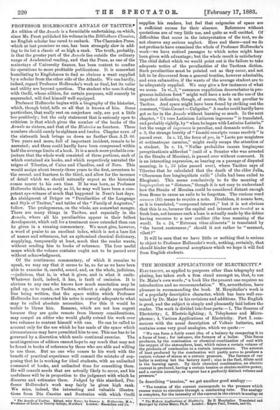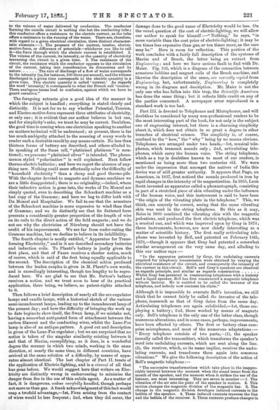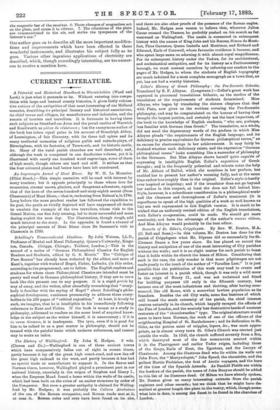THE MODERN APPLICATIONS OF ELECTRICITY.* ELECTRICITY, as applied to purposes
other than telegraphy and plating, has taken such a firm stand amongst us, that, to use Dr. Maier's own words ," a book like the present one requires no introduction and no recommendation." We, nevertheless, have pleasure in recommending the book. M. Hospitalier's work is of a popularly descriptive character, which has been well sus- tained by Dr. Maier in his revisions and additions. The English is good, and the subject is simply and pleasantly laid before the reader. The work is divided into four parts :-1, The Sources of Electricity; 2, Electric-lighting ; 3, Telephones and Micro- phones ; 4, Various Applications of Electricity. Part I. com- mences with the usual description of Voltaic batteries, and contains some very good analogies, which we quote
"We can form a fairly exact idea of a battery by comparing it to a focus of beat; for instance, the furnace of a boiler. This focus produces, by the combustion or chemical combination of coal with the oxygen of the atmosphere, heat, which raises a certain volume of the products of combustion to a certain temperature. The amount of heat produced by the combustion will partly serve to prodaoe a certain volume of steam at a certain pressure. The furnace of our boiler is nothing but the battery itself ; zinc is the fuel, dilate acid is the burning agent. By their chemical combination, an electric current is produced, having a certain tension or electro-motive-power, and a certain intensity, as vapour has a perfectly distinct volatile and pressure."
In describing "tension," we get another good analogy :—
"The tension of the current corresponds to the pressure which causes water to circulate through a conducting tube. The analogy is complete, for the intensity of the current in the circuit is analogcas • The Moduli Applications of Etoctrici'y. By R. Hospitalier. Translated and Enlarged by Julius ldakr, Ph.D. London : Kegan Paul, Trench, and Co.
to the volume of water delivered by conduction. The conductor 'forming the outside circuit is nothing else but the conducting tube ; this conductor offers a resistance to the electric current, as the tube offers a resistance to the running of the water. There are, therefore, with regard to a given electrical circulation, three distinct character-
istic elements The pressure of the current, tension, electro- motive-force, or difference of potentials—whichever you like to call it—the force through which the electric current is established. 2. The volume of the current, its intensity, or the quantity of electricity traversing the circuit in a given time. 3. The resistance of the circuit, the resistance which the conductor opposes to the circulation of the current, taking into consideration its dimensions and its nature The rate of discharge of a flow of water corresponds to the intensity (as, for instance, 100 litres per second), and the volume discharged in a given time corresponds to the electric quantity in a given time. This electric quantity is called current.' As regards the word intensity,' it corresponds to what the French call tension.' These analogous terms lead to confusion, against which we have to guard ourselves."
The foregoing extracts give a good idea of the manner in which the subject is handled ; everything is stated clearly and distinctly. It is not for us to say whether Potential, Tension, and Electro-motive-force represent three attributes of electricity, or only one ; it is evident that our author believes in but one, and for simplicity's sake, we trust he may be correct. Doubtless, the good time is coming when one electrician speaking to another on matters technical will be understood ; at present, there is far too much ambiguity attached to the meaning of many words to render such a desirable result by any means certain. No less than thirteen forms of battery are described, and others alluded to. In speaking of the Smee cell, "platinised platinum" is men-
tioned; we presume "platinised silver" is intended. The pheno- menon styled " polarisation " is well explained. Next follow thermo-electric batteries ; and here we regret the absence of any- thing new. Nothing could more effectually solve the-difficulty of "household electricity" than a cheap and good thermo-pile.
With the chapter devoted to magneto and dynamo machines we are a little disappointed ; there is no originality,—indeed, where their inductive action is gone into, the works of Da Moncel are simply quoted, even to describing the Schnckurt machine as a bad copy of the Gramme ; and here we beg to differ both with Da Moncel and Hospitalier. We fail to see that the armature of the Schuckurt machine is more expensive to wind than that of Gramme; and we do distinctly see that its flattened form presents a considerably greater proportion of the length of wire on its coils to the direct action of the field magnets ; and we do not see why the electrician of Nurnberg should not have the credit of his improvement. We are far from under-rating the Gramme machine, but we decline to believe in its infallibility.
The fourth chapter is neatly entitled," Apparatus for Trans- forming Electricity," and in it are described secondary batteries and induction coils. To Plante's battery is justly given the first place, and that of Faure receives a shorter notice, much of course, which is said of the first being equally applicable to the second. The description of the chemical action produced between the leaden couples is given in M. Plante's own words, and is exceedingly interesting, though too lengthy to be repro- duced here. We are glad to see that Mr. Sutton's battery receives a notice, and we trust soon to hear of its practical application, there being, we believe, no patent-rights attached to it.
Then follows a brief description of nearly all the arc-regulator lamps and candle lamps, with a historical sketch of the various semi-incandescent lamps, leading up to the incandescent lamp of the present day ; and here the difficulty of bringing the work up to date begins to show itself, the Swan lamp, if we mistake not, having a somewhat antiquated form of attachment between the carbon filament and the conducting wires, whilst the Lane-Fox lamp is also of an antique pattern. A good cut and description is given of the Lane-Fox regulator ; but we are surprised that no notice is taken of the singular similarity existing between it and that of Maxim, exemplifying, as it does, in a wonderful degree the manner in which two minds, working in the same direction, at nearly the same time, in different countries, have arrived at the same solution of a difficulty, by means of appa- ratus almost identical. The last chapter of Part II. treats of the application of Electric-lighting, and is a rbrumi of all that has gone before. We would suggest here that writers on Elec- tricity are distinctly wrong in endeavouring to minimise the danger from fire in the use of this subtle agent. As a matter of fact, it is dangerous, unlese carefully handled, though perhaps not more so than gas. A frank acknowledgment of this fact would reap a twofold advantage,—Ist, Fires arising from the contact of wires would be less frequent ; 2nd, when they did occur, the damage done to the good name of Electricity would be less. On the vexed question of the cost of electric-lighting, we will allow our author to speak for himself :—" Nothing," he says, "is more variable than the cost price of electric-lighting ; it may be ten times less expensive than gas, or ten times more, as the case may be." Here is room for reflection. This portion of the work concludes with a fairly full description of the systems of Maxim and of Brash, the latter being an extract from Engineering ; and here we have serious fault to find with Dr. Maier. Fig. 102, which is a diagram of the connection between armature bobbins and magnet coils of the Brush machine, and likewise the description of the same, are correctly copied from Engineering, bat, unfortunately, Engineering is completely wrong in its diagram and description. Mr. Maier is not the only one who has fallen into this trap, the Scientific American has done the same thing ; but it reflects little credit on any of
the parties concerned. A newspaper error reproduced in a standard work is too bad.
Part III. is devoted to Telephones and Microphones, and will doubtless be considered by many non-professional readers to be the most interesting part of the book, for not only is the subject one of engrossing interest, but there is a charming simplicity about it, which does not obtain in so great a degree in other branches of electrical science. The simplicity is, of course, confined to the "how," the " why " being by no means obvious. Telephones are arranged under two heads,—lst, musical tele- phones, which transmit sounds only ; 2nd, articulating tele- phones, which carry the human voice. The string telephone, which as a toy is doubtless known to most of our readers, is mentioned as being more than two centuries old. We were under the impression that amongst the natives of India this device was of still greater antiquity. It appears that Page, an American, in 1837, first noticed the sounds produced in iron by rapid changes in the intensity of its magnetisation. In 1855, Leon Scott invented an apparatus called a phonantograph, consisting in part of a stretched piece of skin vibrating under the influence of the human voice, and this instrument is said to have been "the origin of the vibrating plate in the telephone." This, we think, can scarcely be correct, seeing that the same vibrating skin was used in the string telephone. Be this as it may, Reiss in 1860 combined the vibrating skin with the magnetic pulsations, and produced the first electric telephone, which was a musical one, and which was improved upon by Gray in 1874; these instruments, however, are now chiefly interesting as a matter of scientific history. The first really articulating tele- phone was invented by Bell, and patented on February 146, 1876,—though it appears that Gray had patented a somewhat similar arrangement on the very same day, and alluding to this our author says :—
"In the apparatus patented by Gray, the undulating currents required for telephonic transmission were obtained by varying the electrical resistance of the circuit, and consequently the intensity of the current in this circuit. Bell's and Gray's speakers are identical
as regards principle, and similar as regards construction Whilst Gray has persisted in constructing telephones with a battery and a liquid speaker, Bell has first constructed a magnetic telephone without battery. He is entitled to be called the inventor of the telephone, and nobody now contests his claim."
Although it is impossible to overrate Bell's invention, we still think that he cannot fairly be called the inventor of the tele- phone, inasmuch as that of Gray dates from the same day. Articulating telephones are again subdivided,—lst, those em- ploying a battery ; 2nd, those worked by means of magnets only. Bell's telephone is the only one of the latter class, though numerous alterations, and in some cases, perhaps, improvements, have been effected by others. The first or battery class com- prise microphones, and most of the numerous adaptations :— "Every telephone consists of two parte,—(1), the speaker (usually called the transmitter), which transforms the speaker's word into undulating currents, which are sent along the line. (2), the receiver, which, as its name implies, receives the undu- lating currents, and transforms them again into sonorous vibrations." We give the following description of the action of Bell's magnetic telephone :—
" The successive transformations which take place in the inappre- ciable interval between the moment when the sound issues from the mouth of the speaker, and the moment when it strikes the ear of the listener, are most interesting. They are seven in number ;-1. The vibration of the air sets the plate of the speaker in motion. 2. This motion changes the magnetic division of the magnetic bar. 3. The change in the magnetic division des-elopes induced currents in the bobbin of the speaker. 4. These induced currents traverse the line and the bobbin of the receiver. 5. These currents produce changes in
the magnetic bar of the receiver. 6. These changes of magnetism act on the plate, and cause it to vibrate. 7. The vibrations of the plate are. communicated to the air, and strike the tympanum of the listener's ear."
Our author goes on to describe all the more important modifica- tions and improvements which have been effected in these wonderful instruments, and illustrates his subject fully as he goes. Various other ingenious applications of electricity are described, which, though exceedingly interesting, are too numer- ous to receive a mention here.
















































 Previous page
Previous page